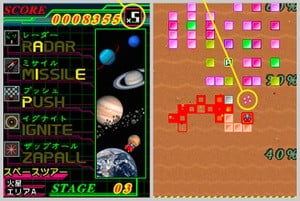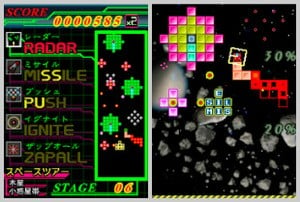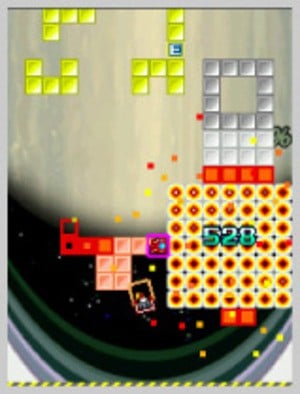
If you've played 3-in-1 WiiWare game MaBoShi, then you'll recognise Moyasu Puzzle Flametail as the "Square" game -- you know, the one that wasn't played with a single button press? The gameplay in Flametail is largely the same as MaBoShi's Square, but there have been some graphical enhancements and the addition of power-ups and a new play mode nicely round this out into a full experience on its own.
The titular square from MaBoShi has been replaced with a little space ship and rather than getting to 1,000,000 points, your goal is finishing a tour of seven planets in our solar system in the main "Space Tour" game mode. The controls are the same: use the d-pad to move your ship about, leaving a "flame" "tail" (get it?) which gradually decays and disappears as you vertically scroll through the levels. If you haven't played MaBoShi the gameplay is pretty basic: as you move your ship it leaves a trail behind it 10 squares long, the last three of which are always in various stages of disappearing. Your tail will ignite blocks that litter the playfield by simply being adjacent to them. Blocks "burn" after being ignited, but not of their own accord: every time you move your ship it acts like stop-motion animation; it's only through movement of your ship that you can clear blocks. If you move too quickly to the top of the screen there is a danger that blocks or even your own tail will hit the barrier at the bottom of the screen that moves up with you, ending your game. Moving back-and-forth as you move towards the top of the screen helps avoid this, but you must plan your movement carefully lest you trap yourself (you cannot move through blocks or your own tail) which also ends your game.

Flametail adds power-ups to the mix which changes the gameplay and adds additional strategy. Power-ups are gained by moving your ship through blocks which contain letters spelling out the names of the power-ups (helpfully for importers the power-ups have names spelled out in English rather than Japanese). Once you've hit all the letters spelling a name a voice will announce it and it will become available or take effect. Initially you'll find the blocks nicely lined up spelling out the names in full, but in later levels there will be scattered letter blocks; requiring more planning to gain a specific power-up.
There are five power-ups in all with two requiring manual triggering and others coming into effect automatically. The passive ones include RADAR, which displays a map of all blocks in the level -- including ones off screen (brilliant for planning movement and avoiding trapping yourself), PUSH, which allows you to push one block around with your ship (this can be a burning block -- including part of your tail) and ZAPALL which destroys all blocks on the screen immediately. The two manually triggered power-ups are MISSILE, which fires off a single missile in whichever direction your ship is facing; destroying blocks in a large radius, and IGNITE which ignites all blocks on the screen as if your tail touched them. Only one power-up can be in effect at a time, so you'll need to consider carefully whether having the RADAR is a bigger benefit than being able to clear the screen or push yourself out of a jam.

Developer Mindware have nicely adapted this title to the DSi. You play with the top screen on the left and d-pad at the bottom "book-style". The left-hand screen displays the letters for the power-ups, your current level, score and the map (assuming you've got the RADAR power-up enabled), whilst the game is displayed on the touch screen with percentages on the right of the screen, indicating how far you are from the level goal. In the options menu you can map the power-up trigger to either L, R or A buttons or a simple screen tap, but otherwise you're just using the d-pad to move your ship.
The graphics are a nice enhancement over the basic MaBoShi game, with the old wood-textured playfield being replaced by stars and planet surfaces (a digitised photo of the Moon's surface appears as a background during level 2) and the blocks being given an extra dose of colour with more greens, purples and pinks. The soundtrack is quite nice too; especially the title theme which plays as accompaniment to some hand-drawn still images in the left screen that tell us the story of the game, and sounds as good as any classic 16-bit soundtrack. In-game music is more muted and combined with the visuals reminds us strongly of the classic Konami game Quarth which is interestingly being released in Japan next week on the Virtual Console.
There's seven levels of the main game and then the additional Timed Mode levels, in which you're trying to see how many points you can score in 3 minutes of play -- perfect for when you just want a quick go. If you do need to stop in the middle of play you'll be pleased to note the DSi's suspend play feature is supported so you can close your DSi and then resume your game later. It's also nice that levels which you've previously reached are also unlocked for direct play later on as well.
Moyasu Puzzle Flametail is a nice slice of arcade puzzling for a reasonable price (500 points), which has more extras to unlock besides levels for replay. If you have a Japanese DSi, it's certainly worth checking out and will hopefully see a release in other territories in the future.
[source nintendo.co.jp]
Comments 10
Looks cool. Is it from the developer of MaBoShi?
I do prefer Circle and Bar to Square though if I'm honest. Anybody who owns MaBoShi can play all three variants on their DS already! It has a DS Download Play option remember
I always found Square to be the hardest of the three in MaBoShi. I've reached a million points in Circle, and I'm on my way there in Bar, but my Square high scores are dreadfully low.
@Gavin: Actually I didn't, but having tried it the fact that it's not something you can keep on your DS makes it a bit less than this which stays on your DSi after you turn the power off. It's also a more fleshed-out version of that game, so it's definitely a new and improved experience.
Hope it comes to the EU, my kinda thang.
I loved MaBoshi.
Sean Aaron. Who else?
MaBoShi was quality, but I say Square was the worst of the three games.
FYI, you can't beat a bit of Bar!
So they take 3 extremely simplistic games (maboshi), separate them, take the worst one, upgrade the graphics (seriously?) and sell it for 500pts. That's genius!!! I wouldn't buy it if it was 1 point.
I really hope they release the Circle game. One of my all time personal achievements is my 1,000,000 on the DS download version.
looks cool. I will give it a try if NoE releases it.
Ok, downloaded this tonight and have played it... only thing I don't like about it is having to play with the control pad and the A button whilst having the dsi turned sideways. I hate having to do that, just doesn't seem natural to me. Anyway, I give it a 5/10 for being colorful and different, and I like the sound effects. hehe... Seems like it could have been much more. Is it just me or does that seem to be the problem with most dsiware games?
Show Comments
Leave A Comment
Hold on there, you need to login to post a comment...